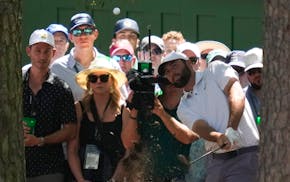San Francisco – On Jan. 25, 1992, the Minnesota Vikings hired the Kansas City Chiefs defensive backs coach as defensive coordinator. On Feb. 10, 1992, the Green Bay Packers traded for an erratic young quarterback who had irritated his bosses with the Atlanta Falcons.
Neither move registered on the NFL's Richter scale. The new Vikings defensive coordinator had been forced out in Pittsburgh in 1989, and the new Packers quarterback prospect, a former second-round pick out of a small school, had thrown just four passes as a rookie. Two were incomplete. Two were intercepted.
Both would try to resurrect their careers in the old NFC Central, facing each other twice a year. On Saturday, their paths intertwined again, when Tony Dungy and Brett Favre were elected to the Pro Football Hall of Fame.
They sat next to each other on a podium after the announcement in San Francisco, and Dungy remembered Favre as an opponent and more.
"I might have gotten here two or three years earlier, if not for him," Dungy said. "I remember just how special he was, how tough he was to prepare for. I can remember our first playoff game up there in Green Bay, and my son just wants to meet Brett Favre. It's 20 below zero, he's dressed like a snowman, and Brett stops warming up to shake his hand and say congratulations for making the playoffs.
"It was a heated rivalry, we were playing two or three times a year, but we had the fun and the respect and the love for playing against each other."
Favre spent most of his career tormenting the Vikings - "Man, I hated him back then," former Viking and Minnesota native Matt Birk said this week - before playing for them in 2009 and 2010. Dungy played quarterback at the University of Minnesota long before Denny Green hired him.
"Going to Minnesota was special for me," Dungy said. "Denny called me in 1992. He had just gotten the job there. Denny was my special teams coach in San Francisco. He wanted me to run their defense. We had some great players - Chris Doleman, who's in the Hall of Fame, John Randle, just some perfect guys for what I wanted to do.
"But more than anything, Denny said, `Hey, I'm going to show you how to be a head coach."
Even while competing in the same division, Dungy would call Green for advice. "He would tell me," Dungy said. "He wanted me to be successful."
In 2009, Vikings fans suddenly wanted Favre to be successful. "It was (surreal), I have to admit," Favre said. "The organization, as well as the fans, embraced me and made me feel welcome. Not unlike going back to Green Bay and how I felt there as well (this fall). I know I created a little confusion there by leaving and going to the enemy. But for me, it was refreshing. It was awkward, but it was refreshing to see it from both sides...My perspective is full circle now.
"Yeah, it was awkward. I have people all the time tell me, 'You really divided my house.' I take pride in that, sort of."
In 1992, Favre and Dungy began popularizing schemes that would dominate the NFL for a decade or more. Favre ran a Midwest version of the West Coast offense. Dungy's "Cover 2" defense was designed to control and punish receivers in such offenses.
Each would win one Super Bowl.
Dungy's defensive prowess helped Peyton Manning earn his only title. Dungy got word of the Hall of Fame honor about 24 hours before Manning would play in perhaps his last game, trying for a second.
"That's how you get here," Dungy said. "Great players."
Dungy and Favre are both known for eloquence. Favre may have given the best weekly press conferences in league history. Dungy became beloved everywhere he worked.
Dungy, though, had trouble describing his emotions, all those years after having to prove himself in Minnesota. "It's surreal right now," he said, "being a part of all this history."
Jim Souhan's podcast can be heard at MalePatternPodcasts.com. On
Twitter: @SouhanStrib. • jsouhan@startribune.com

Souhan: Why Tiger Woods should keep swinging
Souhan: Scheffler wins Masters again, shows what makes him special
Morikawa falters in final round at Masters

Keeping up with the Joneses who helped design Augusta National's classic back nine

